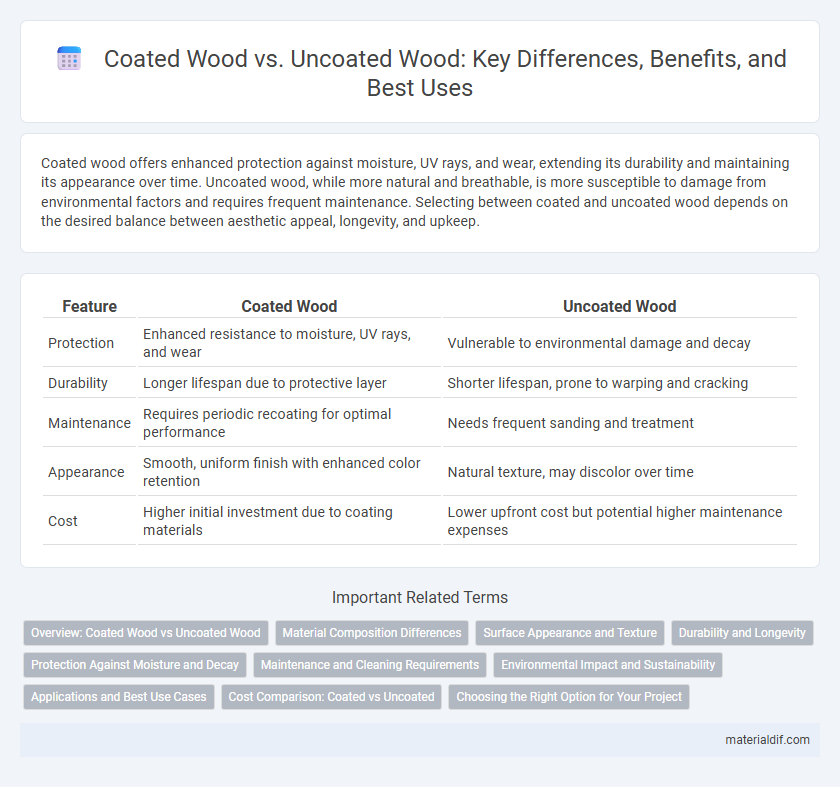Coated wood offers enhanced protection against moisture, UV rays, and wear, extending its durability and maintaining its appearance over time. Uncoated wood, while more natural and breathable, is more susceptible to damage from environmental factors and requires frequent maintenance. Selecting between coated and uncoated wood depends on the desired balance between aesthetic appeal, longevity, and upkeep.
Table of Comparison
| Feature | Coated Wood | Uncoated Wood |
|---|---|---|
| Protection | Enhanced resistance to moisture, UV rays, and wear | Vulnerable to environmental damage and decay |
| Durability | Longer lifespan due to protective layer | Shorter lifespan, prone to warping and cracking |
| Maintenance | Requires periodic recoating for optimal performance | Needs frequent sanding and treatment |
| Appearance | Smooth, uniform finish with enhanced color retention | Natural texture, may discolor over time |
| Cost | Higher initial investment due to coating materials | Lower upfront cost but potential higher maintenance expenses |
Overview: Coated Wood vs Uncoated Wood
Coated wood features a protective layer such as paint, varnish, or sealant that enhances durability, moisture resistance, and aesthetic appeal, whereas uncoated wood remains untreated, making it more vulnerable to environmental damage like rot, insects, and UV exposure. Coated wood requires maintenance of the coating to ensure longevity, while uncoated wood benefits from natural aging but demands more frequent inspections and potential treatments. Selecting between coated and uncoated wood depends on the application, desired lifespan, and exposure conditions.
Material Composition Differences
Coated wood features a protective layer such as paint, varnish, or polyurethane that enhances durability by sealing the surface and preventing moisture infiltration, UV damage, and wear. Uncoated wood lacks this barrier, exposing raw fibers to environmental elements, which can lead to faster degradation and increased vulnerability to stains, scratches, and pests. The material composition of coated wood includes both the natural cellulose-based substrate and the synthetic or natural coating compounds that chemically bond or adhere to the wood surface.
Surface Appearance and Texture
Coated wood features a smooth, glossy surface finish that enhances color richness and provides a uniform texture resistant to moisture and stains. Uncoated wood retains its natural, porous surface with visible grain patterns and texture variations that highlight its organic character but are more prone to wear and discoloration. The choice between coated and uncoated wood significantly affects aesthetic appeal and tactile sensation in interior design or furniture applications.
Durability and Longevity
Coated wood offers enhanced durability and longevity by providing a protective barrier against moisture, UV rays, and insect damage, significantly reducing the risk of warping, cracking, and decay. Uncoated wood, while natural and breathable, is more susceptible to environmental wear and requires frequent maintenance to prevent deterioration. Choosing coated wood extends the lifespan of wood structures and reduces the need for repairs, making it ideal for outdoor applications and high-exposure environments.
Protection Against Moisture and Decay
Coated wood offers superior protection against moisture and decay compared to uncoated wood by creating a durable barrier that prevents water infiltration and reduces the risk of fungal growth. Uncoated wood is more susceptible to absorbing moisture, leading to swelling, warping, and eventual deterioration from rot. Applying coatings such as varnishes, sealants, or paints prolongs the lifespan of wood used in outdoor or humid environments by enhancing its resistance to environmental factors.
Maintenance and Cleaning Requirements
Coated wood offers enhanced protection against moisture, stains, and UV damage, reducing the frequency of maintenance and simplifying cleaning tasks. Uncoated wood requires regular sealing, staining, or painting to prevent deterioration, making it more labor-intensive to maintain. Cleaning coated wood often only involves mild soap and water, while uncoated wood may need specialized cleaners to avoid damage and preserve its natural appearance.
Environmental Impact and Sustainability
Coated wood often involves synthetic finishes that can hinder biodegradability and introduce harmful chemicals into the environment, while uncoated wood allows for natural decomposition and lower ecological footprint. The production and disposal of coatings contribute to environmental pollution, whereas uncoated wood promotes sustainability through its renewable and recyclable properties. Choosing uncoated wood aligns with eco-friendly practices by reducing volatile organic compound (VOC) emissions and facilitating carbon sequestration throughout the wood's lifecycle.
Applications and Best Use Cases
Coated wood is ideal for outdoor applications such as decking, fencing, and siding due to its enhanced resistance to moisture, UV rays, and insect damage. Uncoated wood excels in indoor environments like furniture, cabinetry, and decorative paneling where natural aesthetics and ease of finishing are prioritized. Selecting coated wood provides durability for exposed conditions, whereas uncoated wood offers versatility and natural appeal for controlled, indoor settings.
Cost Comparison: Coated vs Uncoated
Coated wood generally incurs higher initial costs due to the price of protective finishes and labor for application, but offers long-term savings by reducing maintenance and extending durability. Uncoated wood has lower upfront expenses but often requires frequent repairs, treatments, or replacements, increasing total lifecycle costs. Evaluating cost-effectiveness depends on project duration and exposure conditions, with coated wood preferred for environments with high moisture or wear.
Choosing the Right Option for Your Project
Coated wood offers enhanced protection against moisture, UV rays, and wear, making it ideal for outdoor projects and high-traffic areas. Uncoated wood provides a natural appearance and allows for easier customization through staining or painting, suitable for interior applications where aesthetics and flexibility are prioritized. Selecting the right option depends on environmental exposure, durability requirements, and desired finish for your specific project.
Coated Wood vs Uncoated Wood Infographic

 materialdif.com
materialdif.com